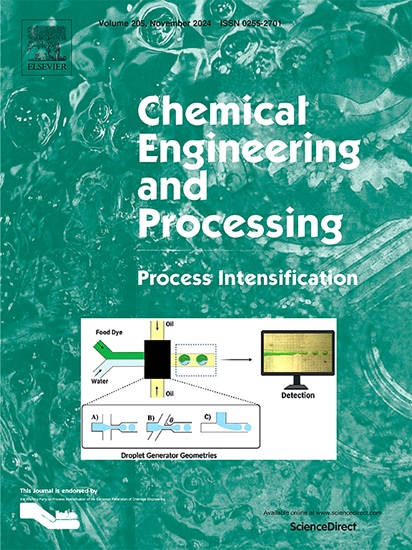高频电场作用下页岩油脱水机理及特性研究
IF 3.9
3区 工程技术
Q3 ENERGY & FUELS
Chemical Engineering and Processing - Process Intensification
Pub Date : 2025-05-01
DOI:10.1016/j.cep.2025.110335
引用次数: 0
摘要
高频脉冲电脱水在原油乳化中应用广泛,但页岩油成分复杂,其脱水机理尚不清楚。本研究评估了6种页岩油样品在重力作用下的脱水性能,并对其中2种样品进行了物性测试、液滴粒径分析和成分评价。研究了电场频率、强度、脉宽比和脱水时间对预处理页岩油在高频脉冲电场作用下脱水效率的影响。结果表明:页岩油中的平均液滴直径在2 ~ 3 μm之间,比常规原油中的液滴分布更小、更集中;确定了两种类型页岩油破乳的最佳参数:SH-A,频率为4 kHz,强度为150 kV/m,脉宽比为50%,温度为60°C,在60 min内将含水率从40%降低到0.69%;SH-B在频率为5 kHz、强度为150 kV/m、脉宽比为50%、温度为60℃的条件下,在50分钟内将含水率从40%降低到0.68%。相比之下,未经预处理的页岩油脱水程度极低。页岩油预处理增强电脱水的理论机理是基于电场中偶极子聚集力的增大。这是通过增加含水量来实现的,这会扩大液滴半径,提高乳状液的介电常数,并减小液滴之间的间距。这些发现为优化页岩油电脱水工艺提供了重要的见解。本文章由计算机程序翻译,如有差异,请以英文原文为准。

Research on dehydration mechanisms and characteristics of shale oil under high-frequency electric field treatment
High-frequency pulsed electrical dewatering is widely used in crude oil emulsification, but the mechanisms for shale oil dehydration remain unclear due to its complex composition. This study evaluated the dewatering performance of six shale oil samples under gravity alone, followed by physical property testing, droplet size analysis, and compositional evaluation of two selected samples. We investigated the effects of electric field frequency, strength, pulse width ratio, and dewatering time on the dewatering efficiency of pretreated shale oils subjected to a high-frequency pulsed electric field. The results showed that the average droplet diameter in shale oil ranged from 2 to 3 μm, which was a smaller and more concentrated distribution than in conventional crude oil. Optimal parameters for emulsion breaking were identified for two shale oil types: SH-A, with a 4 kHz frequency, 150 kV/m strength, 50 % pulse width ratio, and 60 °C, achieved a water content reduction from 40 % to 0.69 % in 60 min; SH-B, with a 5 kHz frequency, 150 kV/m strength, 50 % pulse width ratio, and 60 °C, reduced water content from 40 % to 0.68 % in 50 min. In contrast, unpretreated shale oil is extremely poorly dewatered. The theoretical mechanisms of shale oil pretreatment in enhancing electrical dewatering are based on increasing dipole aggregation force in the electric field. This is achieved by increasing the water content, which enlarges the droplet radius, raises the permittivity of the emulsion, and reduces the spacing between droplets. These findings provided essential insights into optimizing the electrical dewatering process for shale oil.
求助全文
通过发布文献求助,成功后即可免费获取论文全文。
去求助
来源期刊
CiteScore
7.80
自引率
9.30%
发文量
408
审稿时长
49 days
期刊介绍:
Chemical Engineering and Processing: Process Intensification is intended for practicing researchers in industry and academia, working in the field of Process Engineering and related to the subject of Process Intensification.Articles published in the Journal demonstrate how novel discoveries, developments and theories in the field of Process Engineering and in particular Process Intensification may be used for analysis and design of innovative equipment and processing methods with substantially improved sustainability, efficiency and environmental performance.

 求助内容:
求助内容: 应助结果提醒方式:
应助结果提醒方式:


